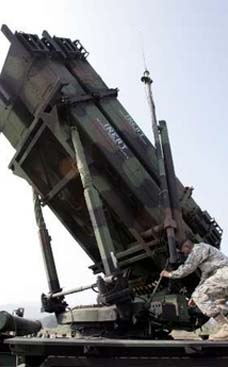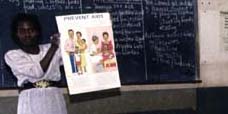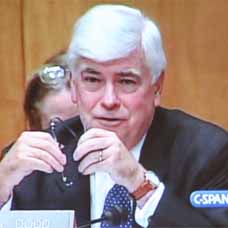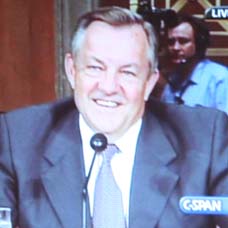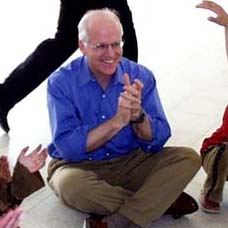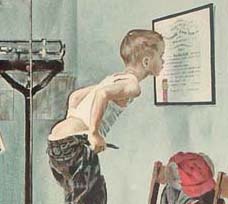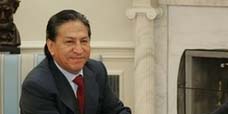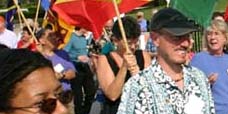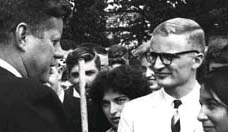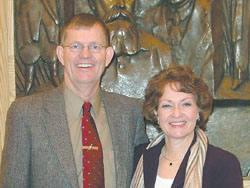
"Language training consisted of four to six hours a day of language classes, five days a week. Interspersed with that training, and on every Saturday, we received cross-cultural and technical training. Peace Corps is very interested in volunteers fitting well into the local society and both language and cross-cultural training aid in this integration. During training we also taught at local schools so that we could learn how Ukrainian schools operate and to help us fit in at our final site. This period was an extremely stressful one for us."
Peace Corps Volunteers Diane and Dave Phelps write about life in Ukraine
Pocatellans head to Ukraine on Peace Corp Mission
Narrative by Dave Phelps
[Excerpt]
Life in Ukraine has been interesting for us. Life, here, is, in some ways, similar to Pocatello, and in some ways, light years away. In some Ukrainian cities, people have ready access to the internet, and in some cities, it is non-existent. Thankfully, we have access to the internet in Bila Tserkva.
Ukrainian school teachers do not get paid very well. They average salary received would be between 250 and 700 hryven a month, which is about $50 to $140 USD. Most teachers supplement their teaching income by tutoring kids on the side. Tutoring pays 10 hryven an hour ($2 USD).
Most Ukrainians still do not own automobiles so there is a very large mass transit system. Most towns have what are called “marshrutkas”, which are vans that have seating for around 14-20 people. Marshrutkas cost 1 hryvnya to ride (about 20 cents) When fully loaded, marshrutkas can hold almost twice the seating capacity because people will stand wedged in to catch a ride. In some of the marshrutkas, the roof of the vehicle is not high enough to stand up, so you stand bent over. The common saying is: “there is always room for one more”. If you are uncomfortable being squeezed from all sides for a 15-20 minute ride, do not get on a marshrutka. You may get on when it has 10 people and the next stop might add 10 more, then the next stop another five. When you want off you must squeeze past every in front of you. That, itself, will test your comfort with being up close and personal with numerous strangers.
Diane has to ride a marshrutka because of the distance, luckily, I think a 20-25 minute walk is just fine and I am not overly enthusiastic about being packed in a marshrutka. We can not always avoid it, but if we can walk, we do. One day Diane and I were going a long distance so needed to take a marshrutka. It was so packed that I actually pushed Diane in, told her I would catch the next one, and had to push to shut the door.
We have also found that many of the conveniences that we had come to expect in America are luxuries here. We have not had a washing machine while in Ukraine, so wash our clothes in buckets and hang them out on a line to dry even in the very cold weather. Dishwashers are almost totally unknown here. In our homestay in Bila Tserkva we had an outhouse to use instead of a toilet. That was interesting when the temperature was -30 C. Many homes do not have running hot water, so water is heated on the stove in pans and used for bathing. Thankfully, in both our homestays, we had hot running water. Some of the other volunteers did not. We either buy bottled water or boil water on the stove before we drink it.
Diane and I enjoy walking, so the opportunity to live in a country where walking is an every day occurrence, not something you do just on Saturday mornings, has been good. In Pocatello, you can always see people walking, but the sidewalks here are covered with people. The sight of so many people walking surprised us.
On March 25, we moved out of our host family's home and into a flat (apartment) on the eighth floor of a nine story building. Because it is a nine story building, it has a lift (elevator). Buildings that have five floors or less do not have lifts. Lifts here are much smaller than in America, approximately three feet by four feet with somewhat low lighting.
Heating in Ukrainian apartments is actually controlled by the City Administration. Water is heated at various locations and is pumped to apartments and businesses. Almost all structures have been built with radiators in them that use hot water to provide heat. The heat can not be controlled in the apartments or businesses. You get the heat that comes and it is what it is. If it is cold, then you will be cold. If it is hot, then you will be hot. The heated water is generally shut off by the City Administration on April 15th and not turned on again until the 15th of October. Some newer structures have begun to build in their own heating system so that they have better control over their own comfort.
In Bila Tserkva there are several large grocery type stores similar to what you find in Pocatello, just as nice and well stocked. In addition to these “supermarkets”, all throughout Ukraine are shops that are called bazaars. These are little individual business spaces operated by everyday people trying to make a living. Most of the bazaar shops are about ten feet square. Some are in metal buildings and are more of a permanent type structure and some are cloth tent like places that can be moved. Most of these bazaar shops are kept open every day. There is a large bazaar in Bila Tserkva that is open on Thursday, Saturday and Sunday. This bazaar brings people from all over to it because of its size. Dotted throughout Ukrainian cities are smaller bazaars that have 20-30 different shops. There are also numerous tables, without any overhead covering, set up around the cities with the proprietors selling a variety of products. The bazaar vendors are there in cold, heat, rain, snow or sunshine.
At a bazaar you can buy everything from vegetables, meat, fruit, electrical appliances, clothing, shoes, picture frames, cigarettes and alcohol (and about anything else you might be looking for). If you need to try on clothes here, the shop owner provides a sheet for you to stand behind to try things on. We are fairly sure we will not be purchasing clothes that we must try on at a bazaar.
Another big difference we have seen here is how people dress. The shoes worn by Ukrainians, both men and women have very long pointed toes. Most ladies dress shoes have four inch spike heels.
Most middle aged and older men wear black leather coats with either a black fedora type hat or the large fur hat seen in many Russian movies. Middle aged and old women wear the large fur hat as well.
Children, in the winter, are bundled up and look like the Michelin man. The littlest ones have a hard time walking so bundled up.
The typical Ukrainian family has one or two children. When we tell them we have four children, they are amazed. Most of the housing here would not support a family with more than two children. Many young married people live with one of their parents until they can afford a flat of their own.
Both the Russian Orthodox and Ukrainian Orthodox churches are quite large in Ukraine. The Ukrainian Orthodox church, while still somewhat affiliated with the Russian Orthodox Church, has its own leader and unified organization within Ukraine. As you travel around Ukraine, you can see many onion shaped domes, some gold, some green and some black, that typically grace the tops of Orthodox churches.
We were members of the Pocatello Church of Christ when we lived in Pocatello. When we moved to Bila Tserkva, we found that there is a Church of Christ here, a group of 18-20 members. It has been interesting to meet with them. They conduct worship services in Ukrainian most of the time, but sing both Russian and Ukrainian hymns. Our language skills are not good enough to understand all that they say. Thankfully, there are a couple of members that speak English so they can translate for us. Hearing traditional American hymns, such as Amazing Grace, being sung in the Russian or Ukrainian language is interesting. Trying to sing it in that language has been a challenge.
As of July 3, 2006, we have been in Ukraine for nine months. Those nine months have gone by very quickly because we have been so busy with training and trying to learn about our responsibilities and Ukrainian culture. We have found the people of Ukraine to be interesting and helpful. There is so much history and tradition here we want to learn, that we think will be busy for the next two years. This is truly an adventure, and the Peace Corps slogan, “The hardest job you will ever love,” is likely going to be quite true.







